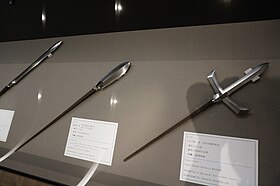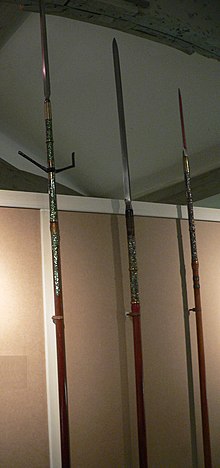
Back Yari AST Яри Bulgarian Yari Catalan Jari (zbraň) Czech Yari Danish Yari German Yari Spanish Yari Basque Yari (keihäs) Finnish Yari French
| Yari (槍) | |
|---|---|
 Yari forged by Echizen Kanenori, 17th century, Edo period (left), sasaho yari forged by Tachibana no Terumasa, 1686, Edo period (middle), and jūmonji yari forged by Kanabo Hyoeno jo Masasada, 16th century, Muromachi period (right) | |
| Type | Spear |
| Place of origin | Japan |
| Production history | |
| Produced | Nara period (710–794) for Hoko yari, Muromachi period (1333–1568) for Yari, since 1334[1] |
| Specifications | |
| Mass | 1.27 kg (2.8 lb) |
| Length | 1–6 m (3 ft 3 in – 19 ft 8 in) |
| Blade length | 15–60 cm (5.9–23.6 in) |
| Blade type | multiple blade shapes |
| Hilt type | Wood, horn, lacquer |
| Scabbard/sheath | Lacquered wood |

Yari (槍) is the term for a traditionally-made Japanese blade (日本刀; nihontō)[2][3] in the form of a spear, or more specifically, the straight-headed spear.[4] The martial art of wielding the yari is called sōjutsu.
- ^ Cite error: The named reference
Fridaywas invoked but never defined (see the help page). - ^ The Development of Controversies: From the Early Modern Period to Online Discussion Forums, Volume 91 of Linguistic Insights. Studies in Language and Communication, Author Manouchehr Moshtagh Khorasani, Publisher Peter Lang, 2008, ISBN 3-03911-711-4, ISBN 978-3-03911-711-6 P.150
- ^ The Complete Idiot's Guide to World Mythology, Complete Idiot's Guides, Authors Evans Lansing Smith, Nathan Robert Brown, Publisher Penguin, 2008, ISBN 1-59257-764-4, ISBN 978-1-59257-764-4 P.144
- ^ Ratti, Oscar; Adele Westbrook (1991). Secrets of the Samurai: The Martial Arts of Feudal Japan. Tuttle Publishing. p. 484. ISBN 978-0-8048-1684-7.